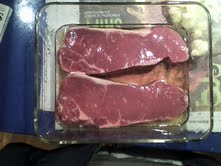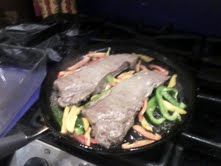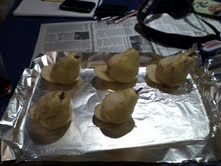'What in the world,' you high-brow non-Philadelphians may ask, 'is Whiz?'. Cheez Whiz is a marvelous concoction, by the good people at Kraft, most analogous to the mustard-yellow cheese melt found on your nachos at a ski lodge.
Of course, a Philly Cheese Steak may not necessarily be enjoyed exclusively with Cheez Whiz (9 out of 10 doctors say it shouldn't). Provolone and American are also acceptable substitutes. But, for that artery-clogging goodness that fills each and every valve of your heart with warm, creamy satisfaction - one really should go for the Whiz.
The first thing you'll want to do when preparing your very own Philly Cheese Steak (after you procure the whiz) is to sauté a bunch of vegetables. Start with your onions because they will take the longest. I cut up three large onions, two white and one red, and put them in a medium saucepan with two tablespoons of unsalted butter, 1 table spoon of canola oil, a teaspoon of kosher salt and a mild dose of ground black pepper. Thus, my onions began to caramelize.
As you may now notice that I used a pretty small pan. This was my fault, but not to worry - as the onions caramelize they become smaller and less opaque. The process should take somewhere between 30 to 40 minutes on medium heat.
Next came the meat. I used two and a half pounds of shaved steak. After quickly coating in salt, pepper and olive oil, I spread the meat on a griddle at medium heat. I poured some extra olive oil over the top of the meat and re-peppered for good measure.
(Sorry for the blur)
You may notice, again, that I used far too small a pan. This affliction that plagued me throughout this meal. I suppose I wanted to feel like the residents of Philadelphia; surrounded by people/things packed into entirely too small spaces.
In case you didn't already realize, Philadelphia is one of America's fattest cities (Reference: Andy Reid).
Now to sauté the rest of your vegetables. Start with your mushrooms, but don't waste too much time before getting to the peppers. You want your peppers burnt, but you don't want your mushrooms cooked to an elastic texture. I recommend Porte Bella. You'll need something to class up your sub, you know, to balance out the Whiz.
Cut your mushrooms into small, bite-size pieces. Put two tablespoons of olive oil and one of unsalted butter into a pan. Let the butter dissolve. Throw in your mushrooms and (a tip from Iron Chief Bobby Flay), add three teaspoons of chopped parsley. Usually I don't trust Flay on anything not involving barbecue or hot sauce, but he's onto something here.
Here are the mushrooms and parsley, getting all nice and sautéed:
(again, the blur - sorry)
By the time you do the peppers you should have the routine pretty much down. Coat heavily in salt and pepper and throw in a pan with two tablespoons of olive oil in which to sauté (most frequently used word in a blog post thus far. I wish it had been a better one, like aphrodisiac of daffodil ).
Just as all your ingredients finish cooking, heat up your Cheez Whiz. No need for anything classy, after all, it's nacho cheese. Any microwave should do. When assembling the sub, I advice you to apply a coating of Whiz first, then the meat, and the vegetables on top. The result is ascetically pleasing and creates the sensation of a "creme filled" cheese center - much like a Twinkie. For future generations viewing this blog: the Twinkie was a highly successful cake-snack, with cream filling, that, despite being sold everywhere, no one actually enjoyed.
At the end of the day, your meal should look like this:
And the happy diner should look like this:
-EM











































